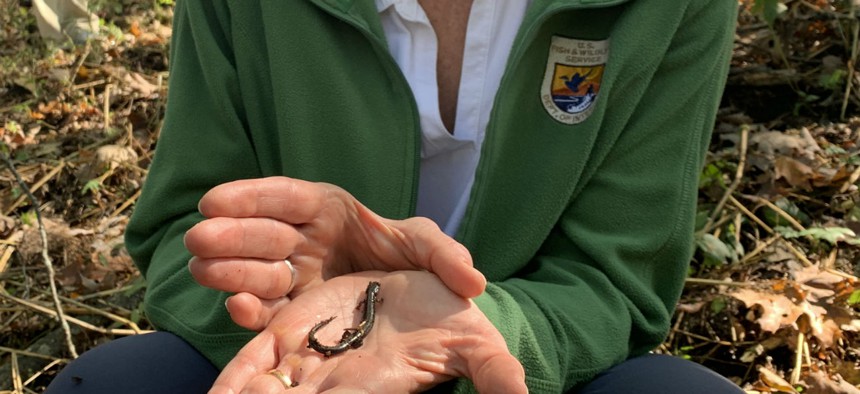
Meagan Racey/USFWS
With Employees Facing Attacks and Murder Attempts, Land Agencies Say They’re Ill-Equipped to Enhance Security
Safety at land management agencies is hampered by law enforcement staffing decreases and border deployments, auditors find.
A law enforcement officer at the Bureau of Land Management recently received more than 500 messages on his personal cell phone, including death threats, after an individual posted his number on Twitter. Another BLM employee was stabbed outside a federal building.
A Forest Service officer came home to threatening graffiti. A Fish and Wildlife Service officer was assaulted by a person wielding a tree branch when investigating a suspected drug trafficking incident.
Those attacks numbered among the 360 reported at the four federal land management agencies between fiscal years 2013 and 2017, according to a Government Accountability Office report. Most of the attacks at BLM, the Forest Service, the National Park Service and FWS resulted from an anti-government sentiment among the perpetrators, GAO said. The FBI has initiated a number of domestic terrorist investigations involving these agencies.
The four agencies are ill-equipped to prepare responses to the attacks, GAO found, as they lack the resources and expertise to deal with them. They have prepared security risk assessments required by the Homeland Security Department on only a fraction of the thousands of facilities hosting employees across the country, leaving them unaware of the risks they face and unprepared with countermeasures to mitigate risks. The lack of planning comes despite a 2014 DHS report that predicted “rising violent domestic extremists targeting government facilities and personnel.”
The count of 360 reported incidents over the five-year period does not actually reflect the full number of assaults and attacks, GAO said. Employees often do not report harassment they consider “part of the job” or a “common occurrence,” while some incidents are reported directly to state and local law enforcement agencies and are therefore difficult to count.
The land management agencies have taken some steps to protect employees, such as maintaining relationships with external law enforcement entities, collecting intelligence on threats and training employees. Those efforts have been complicated, however, by their employees being easily recognizable due to the public nature of their work and the remote areas in which they operate. A drop in law enforcement officers at the four agencies has made it harder to respond to incidents and protect employees, GAO found.
The number of officers has dropped between 7% and 22% at the agencies since fiscal 2013. That decline was exacerbated at the three Interior Department agencies—BLM, FWS and NPS—after then-Secretary Ryan Zinke ordered border deployments for law enforcement staff. Agencies sought to mitigate the impact of the deployments by sharing resources among field units, both internally and externally, so no one facility felt the effects too dramatically.
Agencies have also struggled to adapt due to the unpredictable nature of the incidents. In 2016, for example, an armed militia organized a hostile takeover of the Malheur National Wildlife Refuge, an FWS facility in Oregon, despite the fact that the group was protesting an incident that took place at BLM. President Trump last year pardoned two ranchers, Dwight Hammond and his son Steven, who were sentenced to five years in prison after being convicted of maliciously setting fire to federal property to protest BLM cattle grazing fees.
Federal employees in the area were harassed during the Malheur occupation and experienced confrontations while “grocery shopping, running errands with their families and trying to lead their day-to-day lives,” the county sheriff in Oregon said at the time. Seven of the militia members were acquitted of all charges related to the incident. Twelve individuals pleaded guilty, while four were found guilty in federal court.
Rep. Raul Grijalva, D-Ariz., who chairs the House Natural Resources Committee and requested the report from GAO, said federal leaders should do a better job of denouncing those who cause federal employees harm.
"People at the top of these agencies shouldn’t reinforce or embolden these actions by doing nothing, or by supporting them in the first place," Grijalva said.
Of the four agencies, only FWS had a plan to conduct security assessments on its facilities, the GAO report found. BLM, the Forest Service and NPS said it was up to their regional offices to schedule and conduct the analyses. Field staff told GAO, however, they did not have the resources, relevant training or employees with relevant expertise to make the security risk evaluations. GAO blamed, in part, the “decentralized organizational structures” for those failures. The agencies told the auditors they would make plans for the assessments. DHS standards map out 33 “undesirable events” federal facilities can face, ranging from active shooters to vandalism, and call for agencies to assess the vulnerability to and potential consequences of each. GAO warned agencies were not following those procedures on the few assessments they had conducted.
“Without conducting all of the required assessments, agencies may not identify the degree to which undesirable events can impact their facilities or identify the countermeasures they could implement to mitigate the risks of those events,” GAO said.
Larry Cosme, president of the Federal Law Enforcement Officers Association, said he did not find the report particularly surprising as it reflects the growing concerns members have voiced in recent years.
"I think it’s important these agencies prioritize these assessments and, clearly, do them as soon as possible," Cosme said, adding they should also "call for additional reinforcements." More personnel, he said, would boost the safety of agency employees and park visitors as officers could travel in teams. Agencies should also boost resources for communications equipment, Cosme explained, so officers can always contact their bases or other law enforcement entities for backup.
The House Natural ResourcesCommittee's panel on public lands will host a hearing on Tuesday to discuss "protecting federal employees and ending the culture of anti-government attacks and abuse." In addition to GAO, Oregon-based non-federal officials and a Heritage Foundation analyst will testify.







